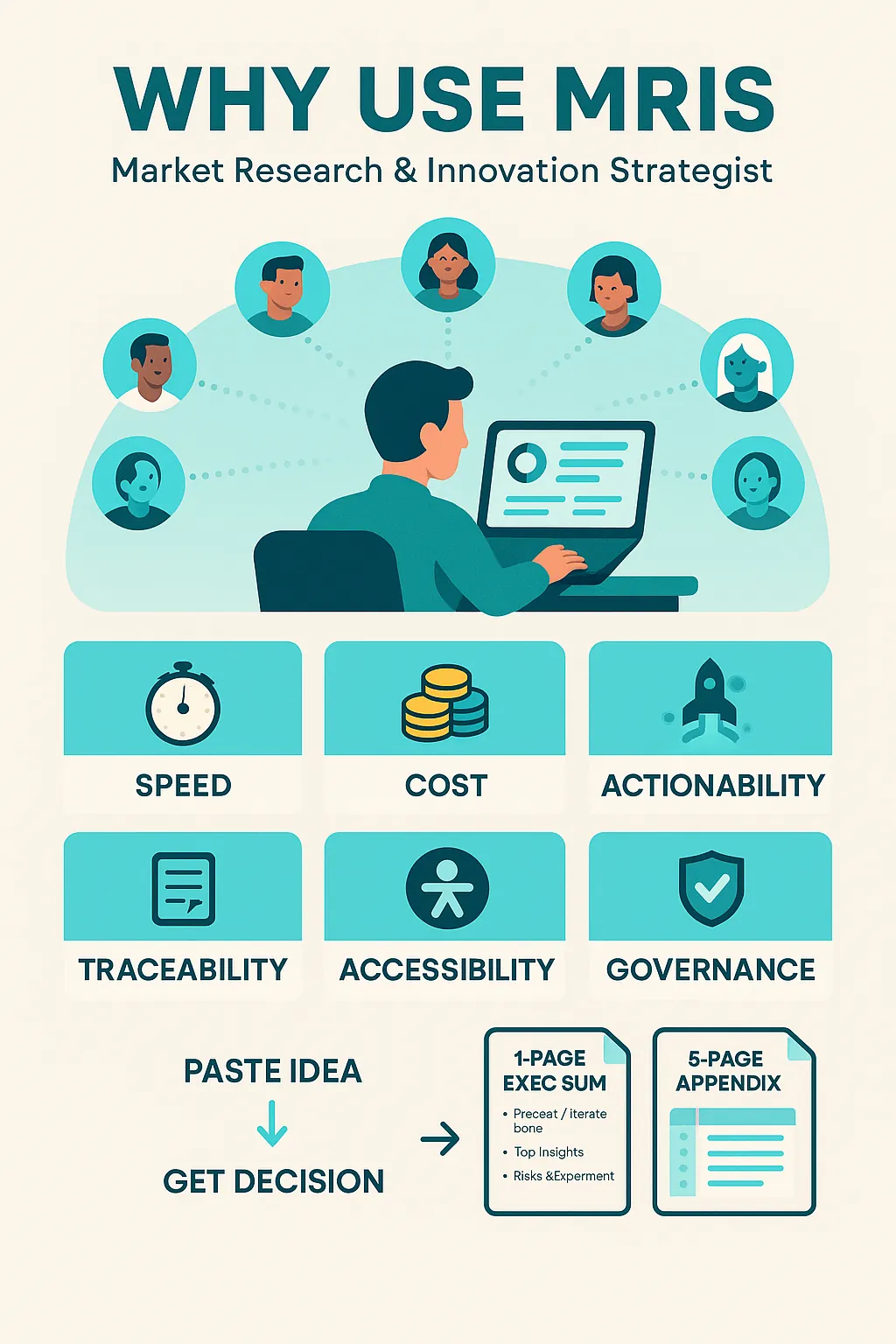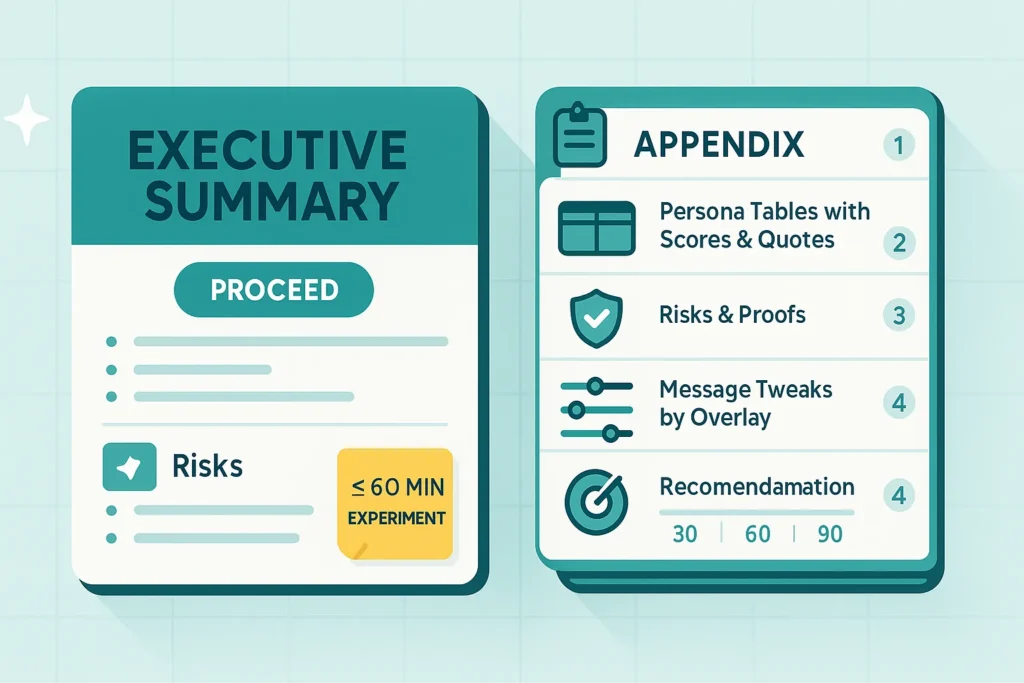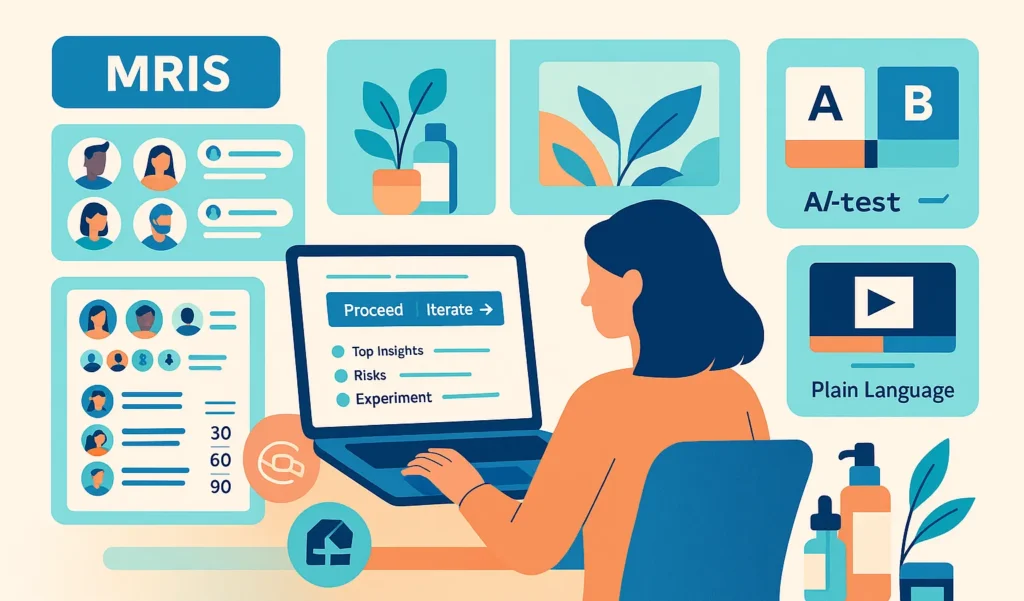Stop Paying Agency Prices for “Target-Market Input” — Run It In-House with Changeable MRIS

Build a Comprehensive Research Room in ChatGPT—Your Way (Simple or Advanced)
A quick story
You’ve got a new idea—maybe a refill option, a small price lift, a wholesale starter kit. You don’t want to wait three months (or pay five figures) to find out if your market will bite. You just want a crisp Proceed / Iterate / Defer and a small experiment you can launch this week.
That’s what Changeable MRIS (Market Research & Innovation Strategist) does. Paste your idea, and MRIS talks to realistic buyer personas, scores the opportunity, surfaces risks and proof needs, and hands you:
1-page Executive Summary (decision + why)
5-page Appendix (offer/pricing/messaging/channel recommendations, risks & proofs, 30/60/90-day experiments with KPIs)
You can run MRIS in two ways:
TL;DR — Choose Your Path
Option A: Beginner (One-Chat MRIS)
Fastest setup. You open one chat, type your idea, and MRIS does the rest. No extra prompts or scripts.
Best for: owner-operators, solo leads, speed.Option B: Advanced (Two-Chat MRIS + Persona Library)
Adds versioning, traceability, and auditing—great for teams and regulated buyers.
Best for: teams who need history, repeatability, and shared persona governance.
Outputs are identical in both paths: the 1-pager + 5-page appendix. Depth depends on how good your target-market personas and overlay variations are.
Option A — Beginner (One-Chat MRIS)
Open the chat, type your idea, get the report.
What you’ll get every time
1-page Executive Summary: decision (Proceed / Iterate / Defer) + top insights, risks, and one ≤60-minute experiment.
5-page Appendix: persona tables with scores & quotes, risks & proofs, message tweaks by overlay, 30/60/90-day experiments with simple KPIs.
One-time setup (≈5 minutes)
Open ChatGPT → New chat.
Rename it: Changeable MRIS – Research & Innovation Strategist.
Paste once (as your first message) the ready-to-run MRIS “single-chat” system block you already have (the one that:
treats any message as a hypothesis,
selects 4–6 target-market personas + 2–5 overlays each,
runs the 10-question guide per persona,
computes scores + Opportunity Score,
returns the 1-page + 5-page deliverables).
(Optional) Pin the chat so it’s always on top.
That’s it. Setup is done.
How to use it (every run)
Open the chat → type your idea in one paragraph:
“Test a refill option with a small price lift to lift average order value by ~10% within 60 days.”Press Send.
Receive the 1-page summary + 5-page appendix—no extra prompts.
Why beginners love this
Zero friction: no prompt engineering, no juggling chats.
Speed: decisions and experiments today, not next quarter.
Focus: one hypothesis at a time → clean signal.
Keep it strong (tiny habits)
Refresh your embedded personas quarterly (tweak goals/pains/triggers).
Add any new proof assets (case studies, SOPs, demo videos) to the system message so MRIS recommends them.
Log each run with one line at the bottom of the chat:
YYYY-MM-DD / hypothesis / decision / top KPI.

Option B — Advanced (Two-Chat MRIS + Persona Library)
Same output, plus versioning, traceability, and auditability.
This path mirrors a lightweight research ops stack:
Chat 1: Changeable MRIS — the agent you talk to.
Chat 2: Persona Library (JSON) — your target-market personas + overlay variations, versioned (e.g.,
personas_tm_v1,v2…).
Why teams choose this
Versioning: know which persona set informed each decision.
Traceability: copy the exact JSON used for a run.
Auditability: perfect for cautious buyers and internal review boards.
Collaboration: product, marketing, and sales can propose persona edits without touching MRIS.
One-time setup (≈10 minutes)
A. Create the two chats inside a “Changeable” project
Project → New Project → name Changeable.
New chat → rename Changeable MRIS → (optional) pin.
New chat → rename Persona Library (JSON) → (optional) pin.
B. Seed the Persona Library (target market only)
Open Persona Library (JSON) → paste the Target-Market Library block you prepared (with:
personas_tm_v1schema,B2B/B2C buyer personas,
overlay sets for demographics/region, psychographics, values, accessibility/channels,
rules: 4–6 personas per run, 2–5 overlays each, balance sex/age_band).
Send it. (That’s your v1.)
C. Load MRIS with its system message
Open Changeable MRIS → paste the MRIS system message that:
asks you to confirm a persona version (default
personas_tm_v1),fetches JSON from the Persona Library chat,
runs the 10-question guide,
returns the 1-page + 5-page outputs,
logs a tiny safety & records note.
How to run (every time)
In MRIS: paste your idea (one paragraph).
Confirm persona version when asked (e.g., “Use personas_tm_v2.”).
In Persona Library: send “Return personas_tm_v2.” → copy JSON.
Back in MRIS: paste the JSON.
MRIS runs the panel and returns the 1-page + 5-page outputs.
Keeping personas fresh (governed updates)
Propose changes in Persona Library:
“Update: add ‘Sensitive-Skin Researcher’ with goals/pains/triggers… bump to personas_tm_v3 and return full JSON.”Approve v3 → next run references
v3.Benefits: you can always say, “This decision used personas_tm_v3.”
Where bullets beat paragraphs (team ops wins)
Audit trail: run date, hypothesis, persona version, decision, key KPI.
Diff view (manual): paste v2 and v3 JSON into your doc to show changes.
Repro runs: re-run the same hypothesis against v2 vs v3 to see drift.

The MRIS “Inside Baseball” (both paths)
The 10 questions
Problem (3): job-to-be-done, current workaround, cost of delay
Solution (3): what it replaces, proof required, “no-brainer” condition
Adoption & Risk (2): biggest risk, who must say yes
Commercial (2): expected price band, trigger for expansion after pilot
Scoring & outputs
Scores (1–5): Value, Urgency, Feasibility, Compliance risk (inverse), Change-effort (inverse) → Opportunity Score
Plus: Willingness to pay and Proofs needed
Outputs: 1-pager + 5-page appendix with 30/60/90-day experiments (owner-operator ready)
What makes results great
Personas that are distinct (not clones)
Overlays you can actually target (age band, region type, values, accessibility)
Proof assets that match the buyer’s trigger (case study, SOP, demo, returns policy)
A practical example - health and beauty

A Health & Beauty brand could set up a small “research room” in ChatGPT (MRIS). For each idea, MRIS would consult realistic buyer personas, score the opportunity, surface risks and proof needs, and return a 1-page decision plus a 5-page appendix with 30/60/90-day experiments. It’s designed for practical next steps—not long reports.
“Do we ship it, tweak it, or shelve it—and what’s the first tiny test we can run this week?”
Simple setup (30 seconds)
Paste a one-paragraph idea into the Changeable MRIS chat.
MRIS consults target-market personas (with human overlays like values, age band, region).
The team receives: a clear Proceed / Iterate / Defer decision, plus a short plan and copy they can use immediately.
Cycle 1 — Supply Chain: sturdier refills, closer components
The bet (hypothesis):
“Switch to sturdier refill packs and source two components locally to reduce breakage and lead time, while aiming to keep unit margin neutral over 60 days.”
What MRIS would likely surface:
Opportunity Score ≈ 4.1 (Proceed – focused pilot)
Buyers ask for proof: drop-test video, 30-day defect-rate report, shelf mockups.
Overlay-guided tweaks:
Cautious Guardian: “Sealed, hygiene-safe refills; SOP available.”
Pragmatic Optimiser: “Fewer returns = stronger margin—see last month’s data.”
Tiny experiments (owner-operator friendly):
Day 1–30: Pilot on two top SKUs (DTC + 10 wholesale accounts).
Track: defect/return rate, days-on-hand, time-to-restock, margin/sku.Day 31–60: Expand if defects ≤ 60% of baseline and lead time −20%; publish a 45-second drop-test clip + 1-page SOP.
Day 61–90: Negotiate component terms; roll to more SKUs if KPIs hold.
Cycle 2 — New Product: sensitive-skin barrier serum
The bet (hypothesis):
“Launch a fragrance-free barrier serum with a 60-day patch-test guarantee; target +8% category lift and stable/low returns.”
What MRIS would likely surface:
Opportunity Score ≈ 4.1 (Proceed)
Likely objections: ingredient proof, fear of irritation, routine complexity.
Proofs that unlock action: derm-backed explainer, patch-test guide, returns clarity.
Tiny experiments:
Day 1–30: DTC trial bundle; seed to three micro-experts.
Track: add-to-cart rate, refunds %, skin-concern quiz completions.Day 31–60: If refunds are at/below baseline and CVR rises 0.3–0.5pp, add a small wholesale pilot (5–10 doors).
Day 61–90: Offer subscription (8-week cadence) and test a refill pack.
Cycle 3 — New Messaging: “Refill + Results”
The bet (hypothesis):
“Lead with sustainability and measurable results; target +10% AOV with stable conversion in 60 days.”
What MRIS would likely surface:
Opportunity Score ≈ 4.1 (Proceed – message test)
Guardrails: avoid “eco-wash”; show 6-month savings and before/after proof.
Overlay-guided tweaks:
Pragmatic Optimiser: “Save 12–18% over six months—see the math.”
Cautious Guardian: “Hygiene-safe refills—45-second how-to.”
Tiny experiments:
Day 1–30: PDP A/B (“Refill + Results” vs. control) + 2-email flow; add the how-to video on page.
Track: AOV, CVR, video completion, refunds %.Day 31–60: If AOV ≥ +8% with refunds at/below baseline, roll to two more SKUs.
Day 61–90: Expand to creator content (“refill routine” series); consider paid amplification if organic improves CAC.
Cycle 4 — Brand Imagery: bolder visuals, better accessibility
The bet (hypothesis):
“Adopt bolder product & skin imagery with captions and dyslexia-friendly layouts; lift PDP engagement without hurting conversion.”
What MRIS would likely surface:
Opportunity Score ≈ 4.1 (Proceed – low risk)
Authenticity beats gloss; include ingredient panels, unfiltered macro, captioned video, clear claims.
Tiny experiments:
Day 1–30: Refresh one PDP and A/B vs. control.
Track: time-on-page, scroll depth, CVR, refunds %.Day 31–60: Expand to category pages; test ingredient panels.
Day 61–90: If CVR holds and engagement rises 10–15%, templatise site-wide.
What MRIS would hand back (every run)
1-page Executive Summary
Decision (Proceed / Iterate / Defer) + 3–5 reasons
Top risks & mitigations (with required proofs)
One ≤60-minute experiment to ship this week
5-page Appendix
Persona tables: scores, WTP, objections & proofs, quotes
Message tweaks by overlay + paste-ready copy
30/60/90-day experiments with KPIs
Small safety & records note
A 12-week roll-up (how this could look)
Weeks 1–2: Supply-chain pilot (refills); serum trial bundle; “Refill + Results” PDP A/B; first imagery test + captions.
Weeks 3–6: Expand what clears thresholds; publish two mini case studies; refine copy via overlay insights.
Weeks 7–12: Add subscriptions (refills/serum); templatise imagery; negotiate component terms; present wholesale results to expand doors.
Track fewer, better metrics:
DTC: AOV, conversion rate, refunds %, subscription attach, NPS
Wholesale: sell-through, reorder cycle, margin per facing, staff minutes
Ops: defect/return rate, lead time
Brand/Content: captioned video completion, ingredient-panel CTR, badge CTR
You don’t need a massive budget to learn how the market will react
A Health & Beauty brand doesn’t need months or a massive budget to learn what the market will actually do. With MRIS, each idea can be turned into a focused conversation with realistic buyer personas—and then into one small experiment that ships this week. That rhythm creates momentum: fewer detours, clearer proofs, and smarter bets.
Want support to stand this up or co-run an initial cycle? Consider getting in touch with Changeable. A short setup can enable a repeatable path from idea to Proceed / Iterate / Defer, with practical copy and KPIs that fit day-to-day operations.
If you’d like help setting up the Beginner one-chat or the Advanced two-chat with versioning, or want a short co-pilot session to run your first MRIS cycle, reach out to Changeable. We’ll get you from “idea” to Proceed / Iterate / Defer with confidence—and leave you with a repeatable way to test the next idea, and the next.
You don’t need an agency to get clear, practical input from your market
You don’t need an agency to get clear, practical input from your market. With Changeable MRIS, you paste your idea and—minutes later—get a decision, the proofs you’ll need, and small, do-able experiments to run this week. That means faster learning, lower costs, and less risk—with copy and steps your team will actually use.
If you’d like help setting up the Beginner one-chat or the Advanced two-chat with versioning, or want a short co-pilot session to run your first MRIS cycle, reach out to Changeable. We’ll get you from “idea” to Proceed / Iterate / Defer with confidence—and leave you with a repeatable way to test the next idea, and the next.
Have a question?
MRIS (Market Research & Innovation Strategist) is an always-on research room: you brief one specialist; it runs structured discussions with the right personas and reports back with decisions, risks, and next experiments. Unlike a traditional agency focus group, MRIS is reusable, faster to iterate, and built for NZ/AU compliance from day one.
Three layers:
Core roles across SME, Enterprise, Government (e.g., Owner-Operator, Finance Controller, CIO/CTO, RIM, Procurement).
Industry-specific SMEs we added (web studios, digital agencies, retail, dealerships, hospitality, hotels/motels, education, industrial design, farm supplies, accounting, insurance, consultants/agencies).
Variant Overlays to capture nuance (sex/age bands, psychographics like Pragmatic Optimiser or Cautious Guardian, values, region/urbanicity, accessibility needs).
Personas describe roles; Variant Overlays add human context (demographic, psychographic, values, accessibility). MRIS samples 2–5 overlays per persona to surface subgroup differences—message resonance, risk concerns, proof needs, and channel preferences—without stereotyping.
We use a structured knowledge base of NZ/AU buyer realities, role/industry constraints, and compliance guard-rails, then run guided, rubric-scored discussions. The output is directional and decision-oriented—perfect for shaping offers, messaging, and pilots. If you need statistically significant survey data, we’ll point you to a quant study after MRIS narrows the questions.
Reports call out NZ Privacy Act requirements, NZ public-sector GenAI guidance (transparency, recordkeeping, risk), and Australia’s AI Ethics Principles (fairness, privacy/security, reliability, transparency, accountability). We also flag records/accessibility for councils and auditability for insurers/enterprise.


